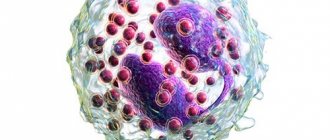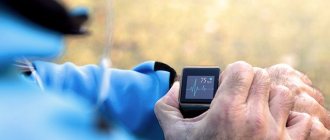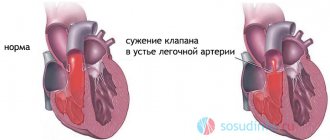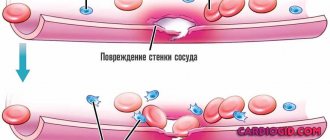Pulse oximetry is used to measure the percentage of oxygenated hemoglobin (oxyhemoglobin) to the total amount of this protein circulating in the blood. The resulting indicator is called saturation; it is used to diagnose hypoxia in children and adults. It can be prescribed as a single or frequent study, as well as for overnight monitoring if sleep apnea is suspected.
Blood oxygen saturation - what is it?
Oxygen saturation is a measure of the oxygen saturation of the blood. The closer it is to 100%, the more gas the cells receive, their viability and the rate of metabolic reactions increase. At full saturation:
- the color of arterial blood is bright scarlet;
- the skin has a natural shade;
- pink tongue and lips;
- respiration and pulse rates are normal.
The first indicator of oxygen deficiency is paleness of the skin, and as the deficiency increases, they become bluish and cyanotic. The heart rate increases and blood pressure decreases. The depth of breathing increases, if a person is conscious, then he feels shortness of breath - even with excessive breathing efforts there is not enough air.
We recommend reading the article about increased blood pressure at night. From it you will learn about the causes of pathology and sudden surges in blood pressure in older people, the dangers of high night pressure, diagnosis and treatment. And here is more information about cerebral hypoxia.
Pulse oximetry norm
The oxygen saturation of hemoglobin in children is typically 95-96%. Exceeding this indicator is recorded during deep breathing in the sleep phase. Concentrations of about 100% are achieved when using oxygen-containing gas mixtures in patients with chronic respiratory diseases.
Pulse oximetry (the norm in adults is 96-98%) is often performed using equipment that sounds an audible signal when a critically low saturation reading is detected. The danger is a drop in value to 94%.
A decrease in the oxygen content in the hemoglobin of an adult patient to a critical level of 90% requires emergency resuscitation measures. In older adults with obstructive sleep apnea, saturation may briefly drop to a life-threatening 80%.
Such patients require respiratory support at night. A decrease in the oxygen concentration in hemoglobin in children to 94% may indicate the progression or exacerbation of pulmonary pathology.
Saturation drops with significant blood loss, hemorrhagic shock and other similar conditions. For smokers, the norm for hemoglobin oxygen saturation is set at 92-95%.
In newborns, the standard value is considered to be oxyhemoglobin volume of 95-96%. It increases in premature infants when a ventilator is used for nursing.
The standard heart rate for adolescents over 10 years of age and adults is set at 60-90 beats/min. For children and newborns, this figure is 70-140 and 110-180 beats/min, respectively.
The principle of the non-invasive method
In order for oxygen to enter the tissues, it must combine with the hemoglobin in the blood contained in red blood cells. If all hemoglobin is combined with oxygen, then blood saturation (saturation) will be 100%. Normally, this figure ranges from 94 to 98 percent when measured in arterial and about 74 percent in venous.
The passage of light through an area of the body depends on how much oxyhemoglobin is contained in red blood cells. This pattern is used in diagnosis using pulse oximetry. The device for this purpose consists of:
- source of red and infrared waves,
- sensors,
- photodetector,
- analyzer.
Hemoglobin without oxygen molecules absorbs red waves, and oxygenated hemoglobin absorbs infrared waves. The device perceives unabsorbed light, analyzes it and displays a digital value on the display. The advantages of this method are:
- non-invasiveness (no need to penetrate the vessels with instruments);
- painlessness;
- accuracy;
- the ability to use for long-term observation (monitoring);
- no qualifications required for measurement;
- portable devices are suitable for home use.
What is a sensor
Depending on the method of recording light waves, two types of pulse oximetry and, accordingly, sensors for them are used. The transmission method involves the passage of light through the fabric, so you need to place the wave source and the detector strictly opposite each other; if there is a bias, the result will be unreliable. Such sensors look like clothespins and are used to clamp a finger or toe or the outer ear.
The reflected diagnostic method is used on a surface where it is not possible to fix sensors on opposite sides (stomach, thigh, head, shoulder). Such devices are configured to perceive light waves that are reflected from tissues. Their accuracy is not inferior to transmission ones, and the possibilities for research are wider. Sensors for this purpose are equipped with adhesive strips, they are removable and designed for one-time use.
What is a finger pulse oximeter
A finger pulse oximeter is a kind of clothespin that is placed on a finger to measure oxygen saturation in the blood (saturation). Hemoglobin, which has attached to itself the maximum number of oxygen molecules (oxygenated), absorbs infrared light, and unsaturated hemoglobin absorbs red light.
The operation of the device is based on this - it transmits red light and then records the reflected light. Using the program, this data is processed, and the saturation indicator is displayed on the monitor. The second value that the device evaluates is the pulse rate.
Fingertip Pulse Oximeter
Fingertip pulse oximeters are needed in hospitals for treatment, operations, and resuscitation measures. Portable devices can be used at home. A doctor may recommend such a measurement in case of lung, heart, blood disease, as well as in patients with sleep apnea. This pathology is accompanied by stoppages of breathing at night; pulse oximetry will help assess their severity.
Indications for the study
Oxygen-saturated concentration can be caused by various factors - from heating intensity to the presence of inflammatory foci. To check your oxygen levels, you can use a pulse oximeter or undergo a blood test (hemoglobin).
When symptoms such as shortness of breath, dizziness, loss of consciousness occur, a laboratory test is often required. An ambulance is rarely needed. In case of carbon dioxide poisoning, it must be taken into account that the rate of exchange of gases (before the ambulance arrives) will increase, and oxygen will be replaced by the time the oxygen level is checked.
Therefore, it is better to ventilate the lungs, allowing the body to become saturated with oxygen, clearing the cells of toxic gas. In outpatient treatment, the analysis is prescribed by a family therapist. In the hospital, blood is donated to determine hemoglobin levels as prescribed by a pulmonologist or cardiologist.
What is a pulse oximetry SpO2 sensor
The SpO2 pulse oximeter sensor is a clip in the form of a clothespin and a cord for connection to a device - a pulse oximeter. The operating principle is based on transmitting red light through a part of the body (finger, ear). The degree of absorption of light waves depends on the saturation of hemoglobin with oxygen.
After analysis by the program, the monitor receives information about the saturation indicator and pulse rate. The specifications usually indicate which models it can be used with. To measure, in addition to the clamp, you also need the device itself.
SpO2 pulse oximetry sensor
The latest developments in the field of diagnostics include the SpO2 sensor built into the Samsung Galaxy Note 4 smartphone. It works with the S-Health fitness application. In addition to the percentage oxygen saturation of the blood, the number of heartbeats per minute is also determined.
What determines the accuracy of measurement?
The method is quite sensitive, so deviations from the rules give false results. Errors in saturation measurements can be caused by:
- incorrect position of the sensors (displacement, weak or excessive fixation);
- bright illumination of the area where the measurement is being taken;
- skin contamination, nail polish;
- physical activity during the diagnostic period;
- anemia (overestimated);
- vasospasm (will show that there is no way to measure or 100% result);
- arrhythmia.
Errors in saturation measurements may be caused by arrhythmia
How much do pulse oximeters cost?
The device looks something like this, although there may be variations
Sadly, their prices have increased significantly since the start of the coronavirus pandemic. This is not to say that they cost exorbitant amounts of money, but a few months ago they could be bought 2-3 times cheaper. A quick study of the offers showed that today the cost in Russia varies from 5,000 to 10,000 rubles and they are in stock . Whether it’s worth starting to buy them headlong is an open question. If you are sitting at home and have absolutely no symptoms, then you don’t have to rush too much. If you are concerned about any of the above, but don’t want to take risks and visit hospitals during this difficult time, it may make sense to explore several options for home pulse oximeters.
Areas of application and indications for use
Oxygen deficiency disrupts the rate of metabolic processes and the production of energy by cells, and since the body does not have reserves for it, without regular supply to the tissues, hypoxia begins. All systems suffer from it, but the heart and brain are the most powerful. Therefore, the first signs of oxygen starvation are:
- dizziness,
- headache and heart pain,
- weakness,
- disturbance of thought processes,
- drowsiness,
- arrhythmia.
Determination of the oxygen content in erythrocytes is used to assess the severity of the condition of patients who have impaired lung function, heart function, or blood composition, during operations, or anesthesia.
Main indications for pulse oximetry:
- respiratory diseases with respiratory failure;
- bronchial obstruction;
- operations using an endotracheal tube;
- the use of drugs that depress the respiratory center, muscle relaxants;
- apnea (stopping breathing during sleep);
- pneumonia;
- lung collapse;
- thromboembolism of pulmonary vessels;
- pulmonary edema;
- heart defects or abnormalities in the structure of blood vessels with blood mixing;
- premature babies;
- oxygen therapy;
- condition after operations on blood vessels, heart, lungs or long-term anesthesia;
- shock or coma of any origin.
Heart defects - indication for pulse oximetry
Functions in the body
The level of oxygen in the blood (the norm in adults is determined by the body independently, as in children, and does not require monitoring in the absence of asthma, hypoxia, or heart problems) depends on a person’s body weight and his age.
Oxygen in the blood is required in a gas state to perform physiological functions:
- The heart pumps blood through a vast network of arteries and veins. Blood is a living fluid. It transports oxygen and other essential substances throughout the body, fights disease and performs other vital functions.
- Blood is a fluid connective tissue consisting of 55% plasma and 45% "formed elements", including red blood cells, white blood cells and platelets. This is the only type of tissue in the body that has such properties.
- Like any tissue, blood needs nutrition. Its functions also include feeding other cells of the body to maintain the functioning of individual organs and the system as a whole. Blood supplies the body's cells with oxygen and removes carbon dioxide.
- In the lungs, carbon dioxide moves from the blood into the air and is exhaled. All anaerobic bacteria and microorganisms are removed along with the gas.
- Oxygen in the blood transports nutrients and hormones. It is there that hormonal compounds are contained, which enter the liquid tissue internally and not from the outside.
- Oxygen plays a large role in digestion and the functions of the endocrine system. Digested nutrients are absorbed into the bloodstream through capillaries in the villi that line the small intestine. These nutrients include glucose, amino acids, vitamins, minerals and fatty acids.
- Oxygen also transports some hormones secreted by the glands of the endocrine system to target organs and tissues. This gas exchange occurs inside the body, and the products of activity do not get outside.
- Oxygen also regulates body temperature. Blood absorbs and distributes heat throughout the body. It helps maintain homeostasis by generating or retaining heat. Blood vessels dilate and contract when they respond to external organisms such as bacteria, as well as internal hormonal and chemical changes.
- When there is not enough oxygen, the protein can clump together. Blood plaques become a threat to life. As blood vessels rupture, platelets and plasma proteins work together to stop blood loss. Platelets, also called thrombocytes, clump together and form a plug in the damaged area. Proteins form strands called fibrins to “set” the platelet plug or clot.
- Oxygen enters the blood from the lungs to supply gas to all human organs. If there are problems with the lungs, shortness of breath occurs. This is all a consequence of lack of oxygen. Due to the damaged organ (lungs), the body does not have time to produce gas to maintain the functioning of the entire system.
- Red blood cells are disc shaped. They are flexible and biocurved - flat and round with recessed centers. This is important when it is necessary to penetrate narrow vessels to supply oxygen.
- White blood cells – 1% of all circulating blood. White blood cells help fight infections, and when the body is damaged, they multiply so that enough oxygen flows in the form of gas through the infected cells. In a gaseous environment, the infection dies.
The physiology of gas transportation in the blood determines saturation - the degree of oxygen saturation of individual organs of the system. When there is not enough oxygen, a person feels dizzy, confused, and lacks strength. Hypoxemia develops against the background of a decline in the normal value. As a result, the blood becomes thicker. Tachycardia sets in - the heart cannot pump fluid tissue at the same rhythm.
To restore and increase blood pressure, you need to help the heart pump fluid. It is easier to push water than a thick mass through narrow vessels. Therefore, monitoring the level of oxygen in the blood is the direct responsibility of all those who have problems with the respiratory system and heart.
What is measured on the finger with the device?
A device with a sensor attached to a finger (similar to a clothespin) measures the oxygen saturation of the blood. This indicator is called saturation and reflects the risk of respiratory failure. It can occur when:
- chronic lung diseases (pneumonia, bronchitis, asthma, tuberculosis);
- acute conditions (blockage of the pulmonary artery with a blood clot, airway obstruction, sleep apnea);
- circulatory disorders (pulmonary edema, heart disease, heart attack, shock);
- administration of certain drugs for anesthesia, muscle relaxation (muscle relaxants).
Pulse oximetry is often prescribed to monitor the condition of patients in intensive care who are in a coma, as well as under general anesthesia during surgery. When the oxygen level drops, the device emits an alert signal, then it is supplied through a mask to maintain life.
Prevention of diseases by oxygenation
For both adults and children, the norm of oxygen saturation in the blood is the same (95-98%). A value of 94% is already considered low and the doctor is obliged to take urgent measures to combat hypoxia. And emergency care must be provided to the patient if this result is 90% or lower. Saturation is measured using arterial blood, which carries oxygen to the tissues. Data from the venous bed are not valuable, since the rate here does not exceed 75% and mainly carries carbon dioxide intended for removal from the body.
24/7 surveillance
In a large number of cases, it is directly necessary to monitor saturation levels at night. This is primarily due to patients who are overweight and have a high degree of obesity, pathologies of the thyroid gland, respiratory tract, and hypertension. These categories of patients are characterized by sleep apnea and sleep apnea, which threaten not only health, but also human life.
People whose nighttime rest is replete with snoring, sweating, who complain of daytime sleepiness combined with headaches, a constant feeling of lack of sleep and irregular heartbeat, most likely suffer from hypoxia. And only a full-fledged study can confirm the diagnosis.
Overnight pulse oximetry should be performed when available:
- unhealthy obesity or obesity of the second degree;
- chronic diseases of the lungs and respiratory organs;
- hypertension;
- myxedema.
If during sleep the saturation level has decreased to 88%, the patient needs oxygenation - breathing with pure oxygen to increase the saturation of the blood with it at night.
Help in diagnosing diseases
The reasons for low saturation are not in the weak saturation of hemoglobin with oxygen (this is only a consequence), but in its insufficient supply to the blood. And using the spo2 indicator, you can determine the nature of the disease, which does not allow you to fully saturate red blood cells with O2. They can be grouped into three main complexes:
- Heart diseases.
- Disturbances in the respiratory system.
- Blood loss.
The causes of weakened cardiac activity are most often coronary disease, pre-infarction condition, failure, cardiogenic shock, etc. In this case, the patient himself may not feel any discomfort. It is then that the saturation indicator becomes decisive when making a diagnosis.
Much has been said above about breathing problems. But a decrease in saturation during blood loss is associated with the loss of a large number of red blood cells and poses a danger, especially for children.
Dangers, consequences and recommendations
The most terrible results of deficiency in O2 cells are necrosis and failure of the most important organs. The heart and brain are the most sensitive to oxygen starvation. Heart attack and stroke, in fact, are necrosis caused by this reason. They are accompanied by weakening of the limbs, a feeling of numbness or burning from the inside. Pre-syncope with elements of hallucinations may occur.
You need to remember that reduced saturation in itself is not a disease; it is always only a consequence of an already existing pathology. Oxygenation is good for temporary stabilization of the indicator, and everything else is part of the treatment of the underlying disease.
And yet, several rules can be identified, if followed, the body’s cells will always be saturated with a sufficient amount of oxygen:
- daily walks in the fresh air;
- consumption of vitamins in the form of fruits and various complexes;
- moderate sports activities;
- treatment and prevention of existing and identified diseases;
- balanced diet.
Saturation is one of the main indicators of a person’s condition. Breathing is the basis of his life. Any deviation from the norm must be checked.
Methodology
This diagnostic method can be prescribed once, for continuous monitoring, only at a certain time of day. Such observation options depend on the purpose of the examination and the preliminary diagnosis.
During the day
Before measurements, exclude any stimulants - energy drinks, tonics, coffee, alcohol is prohibited, as well as smoking (including passive). Drugs that have a sedative effect or act on the cardiac and pulmonary systems are not recommended. Meals can be taken two hours before, but not later. There should be no cosmetics at the diagnostic site. Most often, the measurement is carried out while sitting in a calm, relaxed state.
After fixing the sensor on your finger, you need to keep your hand (or leg) motionless. The auricle can also be used for research; the results obtained with this method are highly accurate. The device then begins measuring the oxygen bound to hemoglobin. The result of the study is displayed on the display.
At night
Attacks of sleep apnea (apnea) are dangerous to the patient's health; their occurrence can even lead to death. Signs of this condition are:
- snoring with periodic holding of inspiration,
- sweating,
- disturbing shallow sleep,
- fatigue and headache after waking up.
To conduct an overnight saturation study, the sensor is fixed so that it is difficult to reset it during sleep; the measurement time is from 10 pm to 8 am.
The bedroom should be darkened and the air temperature should be comfortable. Before going to bed, you should not take medications, especially sleeping pills. The data obtained by the device remains in its memory, on their basis the doctor confirms or excludes nighttime hypoxia. Patients who require such diagnostics usually suffer from:
- hypertension,
- obesity,
- diseases of the lungs and bronchi,
- low thyroid function,
- circulatory failure.
Watch the video about pulse oximetry:
How to try on
To measure at home, you need to purchase a special device - a pulse oximeter. It consists of a sensor that is attached to your finger and an electronic unit with a small screen. To carry out the measurement you need:
- Place the sensor on your finger.
- Turn on the device, which will automatically take measurements.
Data is displayed as percent oxygen saturation. Simultaneously with saturation, the device measures pulse rate. It is important to monitor the battery level; the size of the sensor should match the size of your finger.
Errors may occur in the operation of the device. They are associated with the presence of scars and burns on the hands, swelling, and trembling of the hands. Therefore, try to exclude them to get the most reliable result.
Nail polish can greatly interfere with the measurement, so it must be removed before using the pulse oximeter. Even light and transparent varieties of varnish can greatly distort the results.
Methods for determining blood oxygen saturation
To measure blood oxygen saturation, 2 methods are used - direct determination and pulse oximetry. In the first case, a sample is taken using a puncture (puncture) of the ulnar or femoral artery. This manipulation is performed only by a doctor in a mini-operating room. Arterialized capillary blood can also be used for analysis. It is obtained after the earlobe is pierced.
Pulse oximetry is convenient because it does not require blood sampling or laboratory testing. This is especially important if the patient’s condition is serious and there is a need to quickly get results. The method allows you to evaluate the effectiveness of the therapy or resuscitation.
Bottom line
To summarize, blood oxygen levels play an important role in a person's physical condition. SpO2 - determining the level of oxygen saturation in the blood - is one of the significant indicators for identifying dangerous symptoms that can lead to serious health consequences.
By purchasing a fitness bracelet or smartwatch with SpO2, you can get an approximate picture of your condition, monitor the amount of oxygen in your blood and immediately take the necessary measures if deviations from the norm are identified, which we indicated in our article.
If you know what other fitness bracelets or watches have the SPO2 function, please write in the comments.
- Was the information useful?
- No
Normal indicators and deviations
The measurement technique allows you to simultaneously determine the pulse rate and the degree of oxygen saturation of red blood cells. If a saturation index of 100 percent is obtained when inhaling ordinary atmospheric air, then you need to make sure that the device is working properly.
In newborns and children
The heart rate in babies approaches 140 in one minute, then decreases as the child grows. The content of oxygenated hemoglobin for all categories of patients is considered normal if it is between 95 and 98 percent. In newborns, oxygen therapy may exceed the norm, which is carried out to care for premature babies. This is as dangerous as hypoxia, which doctors have to deal with more often.
In adults
The normal heart rate for all people over the age of 16 is 60 - 90 beats in 60 seconds. Blood oxygen levels should not fall below 94 percent. The critical saturation value is 90%; anything below is an indication for intensive care, including artificial ventilation. The latest models of pulse oximeters have the function of signaling when the indicator drops to a dangerous limit.
Normal blood oxygen levels in women
Normally, women have 95% oxygen in their blood. Indicators close to 100% are possible after inhaling oxygen or hyperbaric oxygenation sessions in a pressure chamber. If they decrease to 94%, then this is already a sign of oxygen starvation. It can be caused by diseases of the pulmonary, cardiovascular, and blood systems.
For women with such diseases, constant monitoring of oxygen levels during pregnancy is especially important, since its lack affects the development of the fetus. When saturation drops to 90%, intensive care is required in a hospital setting.
Causes and symptoms of low saturation
There are many reasons for low blood oxygen levels. Some of them are normal, while others require medical intervention. The latter imply the following situations:
- diseases of the respiratory system (ARVI, asthma, pneumonia);
- violation of the quantitative composition of the blood (decrease in red blood cells or hemoglobin);
- smoking;
- heart defects, ischemia, arrhythmia;
- excess body weight.
During vigorous exercise, oxygen levels may also decrease. The circulation of biological fluid accelerates. At the same time, hemoglobin does not have time to be sufficiently saturated with oxygen. That is why you should only measure saturation in a calm state.
This is the medical norm for oxygen saturation indicators in adults and children. However, in practice, the manifestation of deficiency varies significantly. Among the main symptoms of lack of oxygen, it is necessary to highlight shortness of breath, shallow breathing, and increased heart rate. Such patients experience pale or bluish skin. Children suffer from fatigue and unsuccessful attempts to concentrate on the material.
Pulsemetry of a training session
For training sessions, heart rate monitors are used, which can be in the form of a bracelet or watch. The devices show the intensity of the workout and heart rate, that is, the reaction of the cardiovascular system to the load. In this case, it is possible to select the desired zone (heart rate interval) depending on the goal - fat burning, muscle building, endurance.
A heart rate monitor helps you effectively exercise and select the desired rhythm, since focusing only on your feelings often does not allow you to achieve the desired results.
A pulse oximeter also shows the pulse rate; it is used in sports medicine. But a very important difference is that measuring blood oxygen saturation must be carried out in a state of complete rest. If the indicator drops to 95% or lower, this indicates that the athlete is overtrained and has problems with the heart.
Algorithm and features
Pulse oximetry (the norm in adults is subject to some fluctuations depending on influencing factors) is performed according to established rules. They are determined by the type, goals and technological focus of the survey.
Methods for conducting night diagnostics differ significantly from resuscitation, anesthesiology or neonatal monitoring. Somnological pulse oximetry is a medical monitoring technology for determining peripheral blood saturation over an extended time interval.
Additionally, the device records the amplitude of arterial impulses and the frequency of contractions of the heart muscle. Data is collected over a period of 16 hours. When waking up early and using the pulse oximeter at home, the patient turns off the device with his own hands.
Resuscitation and surgical techniques are characterized by a short-term effect and are aimed at monitoring the physiological state in an acute pathological crisis or during surgery.
During a somnological examination, depending on the length of the unconscious phase, diagnostic equipment records saturation, heart rhythms and the frequency of jerky pulsations 10,000-30,000 times per night.
Screening is performed according to the following algorithm:
- An electronic digital unit with an integrated microprocessor is attached to the wrist of the left hand.
- A emitting sensor of a clip design is placed on the upper phalanx of the finger of the same hand. To obtain an accurate result, it is important to correctly place this functional element. The infrared emitter is placed above the nail plate at the maximum distance from the junction of the lower phalanx to the palm.
- The device is automatically activated immediately after installation.
- The read physiological parameters are displayed graphically on the monitor display.
During somnological pulse oximetry, night awakenings should be scrupulously recorded in a previously established diary. The device must remain connected and activated throughout the monitoring period. The data obtained is transferred to the doctor for interpretation and evaluation.










